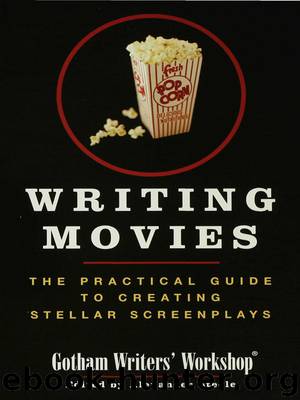Writing Movies: The Practical Guide to Creating Stellar Screenplays by Gotham

Author:Gotham
Language: eng
Format: azw3
Publisher: Bloomsbury Publishing
Published: 2008-12-18T16:00:00+00:00
Let me point out a few basic things that will help you achieve this kind of naturalness.
Don't worry about perfect grammar. People don't always speak grammatically; no reason they should in movies. Notice how Andy drops pronouns—"Wanted it to be a surprise"—and doesn't use complete sentences—"Anniversary gift." He also uses the very ungrammatical "gonna," as people often do in real life.
Use contractions. Red doesn't say, "It is very pretty." He says, "It's very pretty." In real life, people almost always use contractions when possible. Lack of contractions is a sure path to stilted speech.
Keep it moving. Don't let any character ramble on for too long before the other character speaks. Real-life conversation usually bounces back and forth like a Ping-Pong match. Note that you can also get that back-and-forth going between character "lines" and bits of physical action. Red is pensive in the Shawshank scene so Andy does most of the talking, but his lines are interrupted with bits of action with the harmonica. Rule of thumb: You shouldn't go more than three or four lines each time a character speaks unless there is very good reason.
A good way to ensure that your dialogue is natural is to read it aloud. It should fall trippingly off the tongue, feel real to you as you speak it. If your dialogue is phony, you'll know it as soon as you're forced to act it out yourself.
Aside from that, it's just a matter of developing your ear so you have a feel for the way people actually talk. Listen to how real people talk. Pay attention to what they say. What verbal tics do you notice? How is the way people really talk different from what you thought? You might even transcribe pieces of overheard conversations to see what authentic talk looks like on the page.
But hold on a moment. Time to spin this around with a paradox. I've said that dialogue should sound real—but the fact is, dramatic dialogue is actually far removed from real-life speech. We falter all over the place when we speak, and often we take forever to get to the point. Mere transcriptions of conversations are duller than dishwater, and you'd be committing a felony against your audience if you made them sit in the dark and listen to it. Dialogue is not real-life speech, but it should give the illusion of being so. Dialogue is actually a highly compressed version of everyday speech. If drama is anything, it is the essence of life, the boiled-down version of the everyday that carries a punch and says something at all times. Any great story, from your whiz-bang actioner to your quietly pitch-perfect drama, keeps the audience on their toes at all times with new information. If you look back at that Shawshank passage, you'll see that every line has meaning, carries the drama forward in some way. Every word matters.
Now, take a look at the same scene from Shawshank, with the dialogue uncompressed.
EXT. PRISON YARD - DUSK
Red emerges into the fading daylight.
Download
This site does not store any files on its server. We only index and link to content provided by other sites. Please contact the content providers to delete copyright contents if any and email us, we'll remove relevant links or contents immediately.
| Coloring Books for Grown-Ups | Humor |
| Movies | Performing Arts |
| Pop Culture | Puzzles & Games |
| Radio | Sheet Music & Scores |
| Television | Trivia & Fun Facts |
The Kite Runner by Khaled Hosseini(5061)
Gerald's Game by Stephen King(4556)
Dialogue by Robert McKee(4306)
The Perils of Being Moderately Famous by Soha Ali Khan(4156)
The 101 Dalmatians by Dodie Smith(3440)
Story: Substance, Structure, Style and the Principles of Screenwriting by Robert McKee(3384)
The Pixar Touch by David A. Price(3345)
Confessions of a Video Vixen by Karrine Steffans(3230)
How Music Works by David Byrne(3157)
Fantastic Beasts: The Crimes of Grindelwald by J. K. Rowling(2975)
Harry Potter 4 - Harry Potter and The Goblet of Fire by J.K.Rowling(2974)
Slugfest by Reed Tucker(2923)
The Mental Game of Writing: How to Overcome Obstacles, Stay Creative and Productive, and Free Your Mind for Success by James Scott Bell(2836)
4 - Harry Potter and the Goblet of Fire by J.K. Rowling(2639)
Screenplay: The Foundations of Screenwriting by Syd Field(2561)
The Complete H. P. Lovecraft Reader by H.P. Lovecraft(2499)
Scandals of Classic Hollywood: Sex, Deviance, and Drama from the Golden Age of American Cinema by Anne Helen Petersen(2453)
Wildflower by Drew Barrymore(2431)
Robin by Dave Itzkoff(2369)
